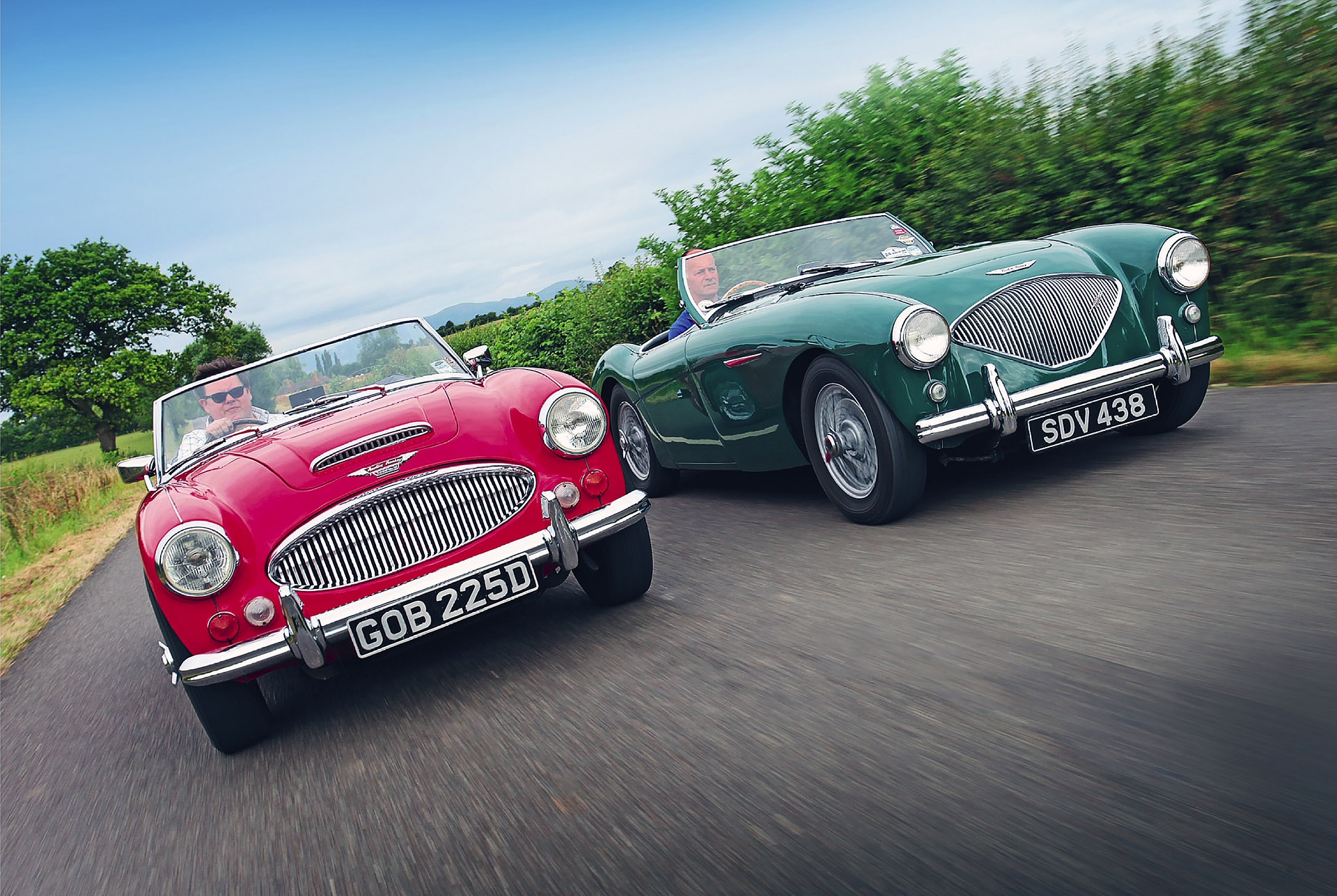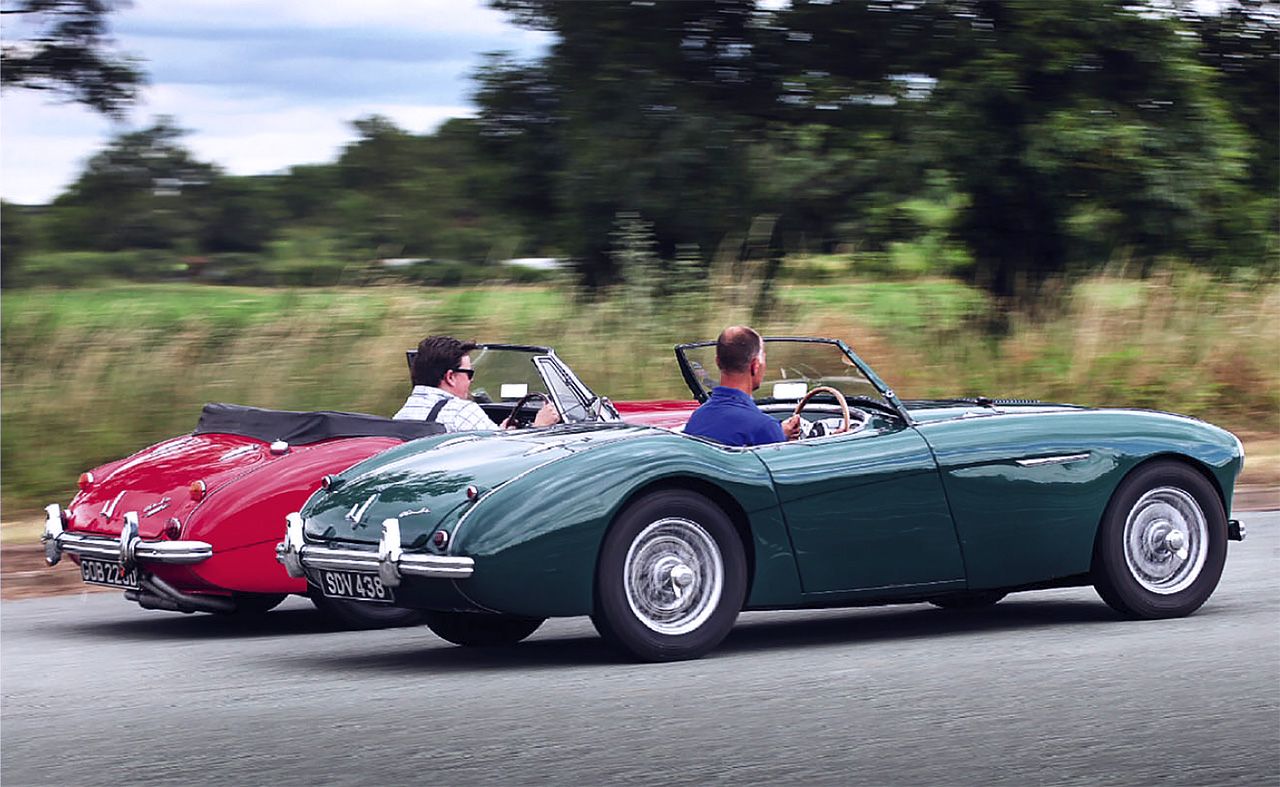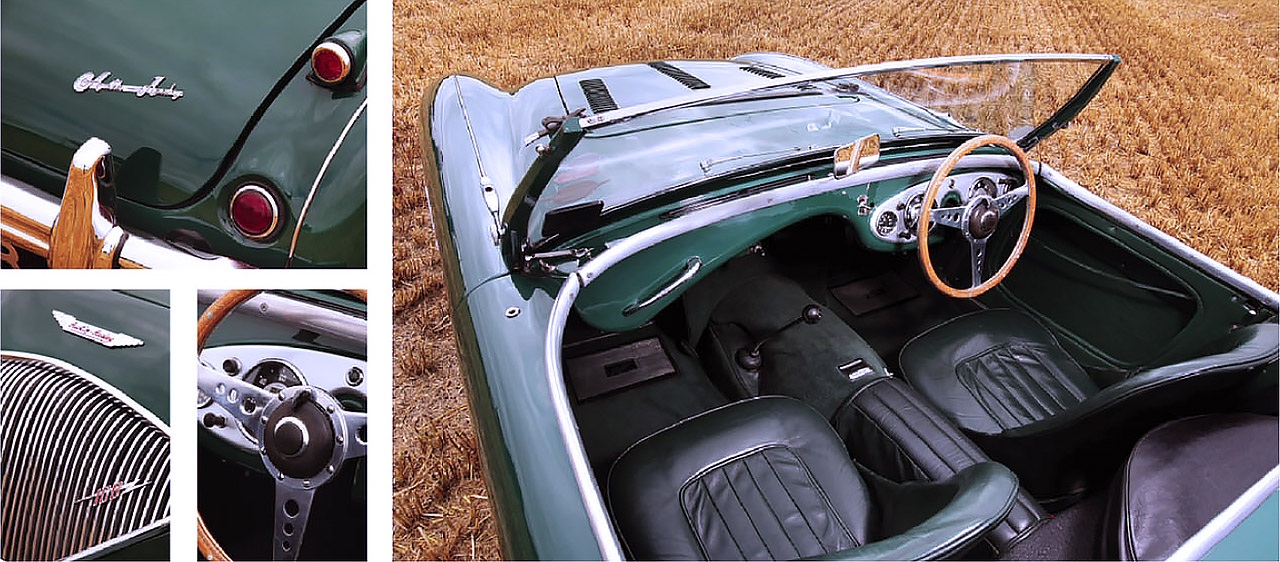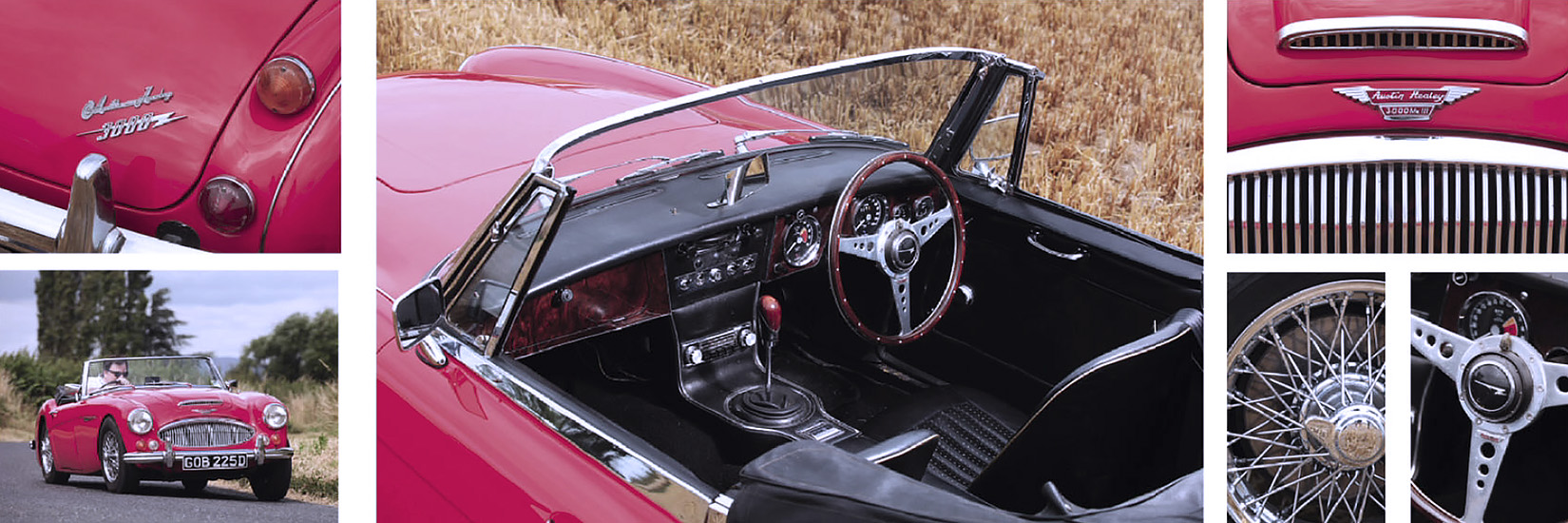
Austin-Healey – Heley hits the big time! Why this is still Britain’s finest sporting dynasty? When a small family firm joined forces with Austin, an enduring classic was born. Simon Charlesworth compares 100 to 3000. Photography James Mann.
The biography of the 1952 Austin-Healey 100 could be subtitled: ‘The role of failure in success.’ Following World War 2, Austin seemed to have mislaid its sporting mojo, which, given the lucrative nature of overseas markets to its competitors, was certainly egg on face for Longbridge management.

While the 100 rides along on an impressive wave of torque, the later 3000 is much happier being revved a little harder
It wasn’t for want of trying, though. In 1950, the company had collaborated with Jensen to produce the 78mph A40 Sports – a car that, despite wearing appealing Eric Neale-designed bodywork-was as invigorating and enjoyable to drive as a flock of damp sheep. A mere 4011 were produced until it was superseded by the equally soporific A40 Somerset Coupe of 1952.
That was also the year in which the company culled its A90 Atlantic – certainly the most important Longbridge miscalculation in relation to the eventual matchmaking of Austin with Healey. Embellished with buxom 1940s Americana-style full-width bodywork and precocious detailing, Leonard Lord’s grab for an ‘export or die’ slice of Uncle Sam’s market was as convincing as a jitter-bugging Margaret Rutherford. In the deluxe land of V8s, power assistance and chrome-plated specification, the Atlantic’s lack of cylinders and performance – and its A70 chassis – combined to yield an expensive dollop of tepid mediocrity. Of the 7981 built, only 350 struggled westward across its namesake ocean, leaving an abundance of leftover components.

Conversely, the little Donald Healey Motor Company understood the recipe for export and sporting success. Yet, the nearest that the firm had come to offering an affordable car was the 1947 Duncan Drone. Built on a Healey chassis and powered by the 2443cc Riley twin-cam engine, the 116mph Drone was intended as a sub-£1000 sports car. Wearing plain, almost dour, aluminium Duncan bodywork, the intention was that customers would subsequently rebody their cars – thus side-stepping material shortages and the high Purchase Tax of more expensive Healey models. Alas, a mere 10 of these spartan, wasp-tailed, cycle-guarded, coffin-nosed cars were built, with just three believed to have been outfitted with new bodies.

Clockwise, from main: 100 turns in crisply; engine sourced from Austin A90; gorgeous profile; simple, elegant cockpit – but note position of gearlever; deeper front grille and delicate tail lights
The body was rakishly contemporary yet unfussy and perfectly proportioned

The Drone’s lack of success wasn’t the only problem hanging over the company’s Warwick works. The glam-but-attainable Jaguar XK120 was knocking lumps out of the company’s other models, and the Riley twin-cam- one of Healey’s favourite engines – was not long for this world. The Nash-Healey may have been safe, but the company felt somewhat ill at ease about being dependent on only one model.
The solution to its problems and lack of export penetration came with the production of the Healey Hundred. It became one of the most successful lines of British sports cars, built around mass-produced Austin know-how and Healey sporting acumen – a series that could turn its wheels to record-breaking, rallying or circuit racing. And a saga that is neatly bracketed by our pair of ‘book-ends’: a 1955 BN1 100 and 1965 BJ8 3000MkIII Phase II.
The car was created by Donald Healey and his son Geoff to exploit the price and performance gap in the market between the 80mph square-rigger MG TD and the 120mph glamour-puss Jaguar XK120. Suitable power units for the new Healey Hundred were discussed with the likes of racer/journalist Tommy Wisdom, who recommended the A90’s 2660cc ‘four’ – a unit with a lower power yield and weight than the Riley twin-cam. With the engineering design initiated, Donald Healey approached Leonard Lord on 27 November 1951 with a view to engine supply; not surprisingly, he was greeted favourably. It provided a use for the unwanted four-cylinders, and also meant that Austin had got one over on Lord’s former employer and great rival, the Nuffield Organisation.
Geoff Cooper from Austin’s design office liaised with DHMC. The chassis was designed by Geoff Healey and Barry Bilbie, while the bodywork – rakishly contemporary yet unfussy and perfectly proportioned – was styled by Gerry Coker under Donald Healey.
Launched in October 1952 at the International Motor Show in Earls Court, the car impressed Lord – who shook hands on an agreement with Donald Healey. The car quickly became the Austin-Healey 100, and in an instant, DHMC’s lack of production capacity – 10-25 per week had been envisaged – would be vastly increased by the mighty Longbridge.
Capable of 104mph with hood and ’screen up, or 111mph with its folding windscreen lowered, it was hardly surprising that the £750 (plus taxes) 100 was the star of the show.
To the motor-literate, cars are often the exception to the ‘don’t judge a book by its cover’ rule. Go with your intuition and you’ll be pretty accurate in ascertaining what each of these Healeys is like to drive. The raunchier BN1 100 is the slinky off-the-shoulder number, while the more mature BJ8 3000 MkIll deftly balances respectability with sensuality.
While there was a loss of design purity over the production run, the Healey avoided a midlife facelift inflicted by Mr Magoo and the ugly stick, and managed to broadly retain its youthful good looks until it finally retired in 1968. That isn’t to say, however, that anoraks will be denied a lengthy game of spot the differences, for there are many – from the swage line and front wheelarch profile to the oval Austin grille, bonnet air-intake and extra lamps.
Hop aboard a Healey 100 and a smile comes with you. The BN1’s elegant dashboard is amongst the most attractive fitted to any car thus built – a mere suggestion of body colour (Spruce Green, in this case) bearing a silver oval and a quartet of Art Deco-typeface Smiths dials. The BN1 interior is a tonic against today’s luxuriantly specified ‘sports cars’, for, aside from the main controls, the 100 has a heater, a bit of cushioned padding on the transmission tunnel and an aluminium rail that cordons off the outside world from in here – that is all.
Legroom may be bordering on insufficient – punting my forehead clear of the windscreen header-rail – but there is plenty of shoulder room. The close steering-wheel boss stares at your chest and the pedals are slightly offset to the right, while the overdrive three-speeder’s long gearstick sprouts like a gangly sapling from the transmission tunnel’s nearside. Originally a column-change on the A90, the gearchange is a right-hand-drive H-pattern with the Atlantic’s low first blanked off.

Clockwise, from main: BJ8 pips BJ1 in terms of acceleration; neat details and chromed wires; cabin is slightly more roomy and better equipped; late 3000 is a bit softer than 100; sonorous straight-six
The Healey avoided any ugly facelifts and broadly retained its youthful good looks

If the BN1’s fluttering-ribbon dashboard has all the titillating appeal of a St Tropez bikini, then the wood-veneer item in our featured BJ8 is as steadfastly respectable as a Victorian vicar’s sideboard. Chrome bezels pepper the walnut veneer, there’s a speaker for an optional radio, proper doorhandles, a 140mph speedo, a vinyl-trimmed centre console with armrest, a line of toggle switches anticipating action and – by Jove – a shorter gearstick that doesn’t seem to have germinated on the dark side of the moon.
Quarterlights and retracting side windows pilfer some shoulder room, but the BJ8 compensates with more legroom in a footwell that houses three top-hinged pedals. The dash top-mounted mirror, meanwhile, is rendered useless by the pram-like convertible hood. Still, if you’re worrying about what’s behind you in a Healey then you’re not driving it properly.
The smaller 2639cc C-series and longer- wheelbase 2+2 body option – which chomped a sizeable bite out of the Healey’s graceful rear deck- arrived with the 100-Six of 1956. This was the last ‘squealie’ to be produced at Longbridge before production switched to MG’s Abingdon plant during the 100-Six’s run.
As Austin-Healey customers matched and hatched, the two-seater roadster was phased out after the BN7 3000 MkII – a mere 355 of which were built between 1961-’62, compared to 5095 of the 2+2 BT7. From the MkII onwards, the 3000 also benefited from disc front brakes with optional servo assistance for delicate types who desired matching thighs.
The final Healey iteration, the BJ8, entered production in October 1963. Larger HD8 SU carburettors sitting on a new intake manifold, bigger valves, new camshaft profile, revised timing and new exhaust system increased power from 134bhp at 4750rpm to 150bhp at 5250rpm – upping maximum speed from 116mph to 125mph. In terms of acceleration, the BJ8 became the first six-cylinder Austin-Healey to improve upon the BN1’s 10.3 secs 0-60mph time, lowering it to 9.5 secs.
In May 1964 came the final raft of improvements courtesy of the Phase II model. Most were aimed at improving the car’s ground clearance and comfort – the underslung main rear chassis rails were redesigned and repositioned, for example, reducing the Healey’s tendency to beat up its exhaust over any surface rougher than untouched bitumen. Softer springs were fitted along with dual radius arms at the rear, rather than the Panhard rod fitted to previous models.
The end for the ‘Big’ Healey came on 14 March 1968, with the C-series engine being at the end of its development life and the 3000 being unable to meet American regulations for emissions and crash protection.
After a sultry sortie over cracking country roads, how do the prologue and epilogue to the Austin-Healey story compare? Two strong and differing characters emerge.
Driving a BN1 is like a rowdy night out with an old mate. Winding roads, 144lb ft of torque at 2000rpm, working ears and a degree of mechanical sympathy make the tacho redundant. The 100’s four-pot may produce 94bhp at 4000rpm, but only a bounder would take it up to these revs – for the further it ventures, the more strained the engine note becomes. That said, the soundtrack isn’t unpleasant in the way that an over-extended sidescreen TR ‘four’ can be. Instead, it complements the BN1 ’s unprocessed, almost pre-war driving experience.
Corners are greeted with a waspish, quick-witted turn-in, the firm ride equates to great poise and the back end obeys your right foot’s every command. The Burman worm-and-roller mechanism is pretty responsive, reducing the margin for straight-ahead dithering – where many other steering boxes feel as if they lose interest and are blatantly daydreaming. The three-speeder’s change – flicking in and out of overdrive – becomes second nature, while the drum brakes banish speed with good feel and efficiency in return for a modest workout.
Jumping from the 1950s to the ’60s, I must confess to a degree of indifference due to past disappointment at the wheel of a 3000 MkI – namely its underwhelming 124bhp Type-29D engine. There is a vast difference, however, between the MkI’s wheezy C-series and the MkIII’s reformed Type-29K. The later engine not only produces more oomph at higher speeds, but those twin exhausts proclaim that it enjoys singing for its supper.
Dynamically, the BJ8 is the more rounded car. It rides better, at the expense of some poise, while not letting those softer springs ruin the cornering fun. The gearbox is slightly sharper and quicker, and the assisted discs and drums set-up requires less effort for greater retardation. The BJ8’s detached Cam Gears steering box, however, isn’t as quick, faithful or consistently positive as the BN1’s when threading corners together or even just blasting up straights. There is also a price to pay for that extra legroom, for the longer wheelbase brings noticeably less torsional rigidity and more wobble. Overall, the MkIII does feel softer and less eager than the 100, but it still thrives through snaking complexes, with the rear end all too willing to pop around for a spot of cheeky fun.
So which is better? The 100 remains favourite, but the 3000 MkIII deserves the moral victory for returning the Big Healey to its impressive square-jawed self during a time when its parent firm was losing the plot. Not only has the BJ8 helped to erase that disappointing encounter with an asthmatic MkI, but it highlights the short-sighted insanity of BLMC’s decision to abandon the market to the likes of the Datsun 240Z and TR6.
Perhaps if the Healeys had been charged with a fraction of the development budget frittered away on the BMC Fireball XL5, then the 1970s might not have been such a gloomy decade for devotees of the British sports car.
Thanks to Mark Knight; Guy Packer; the Austin-Healey Club UK (austinhealeyclub.com); Retro Morques (retromorques.co.uk)
What could have come next
1963 XC512 ‘FIREBALL XL5’ ADO30
Based on a winning entry for a L’Annee Automobile competition at West Germany’s Hochschule fur GestaItung, this fixed-head coupe design was applied to the 3000 by Pininfarina. Rights secured, Longbridge developed it into a sports car/GT to sit above ADO51. It used Hydrolastic suspension and surplus Vanden Plas 4-litre R engines, but other configurations were considered during its resource-gobbling gestation. Poor handling, staff indifference and its E-type-beating mission – post-1966 BMC-Jaguar merger – meant that it was cancelled by BMH in 1967.
1966/1967 AUSTIN-HEALEY 3000 MklV
A six-cylinder variant of the MG B had always been planned, but it wasn’t meant to look so similar to its four-cylinder sibling. ADO51 was the stillborn sister of AD052, which became the MGC. BMC/BMH’s woeful finances meant that differences between the MkIV and the MGC were reduced to cosmetic touches. The Healeys were not impressed – the car no doubt suffering from problems caused by its under-performing, Type-29G C-series – and refused to lend their name to it. It was canned at the 11th hour.
| Car | Austin-Healey 100 | Austin-Healey 3000 MkIII Phase II |
| Sold/number built |
1953-1955/10,688 |
1964-1967/16,322 |
| Construction |
steel box-section chassis, with steel body |
steel box-section chassis, with steel body |
| Engine |
all-iron, overhead-valve 2660cc : ‘four’, twin SU H4 carburettors |
2912cc, in-line six-cylinder, ohv, twin 2in SU HD8 carburettors |
| Max power | 94bhp @ 4000rpm |
148bhp @ 5250rpm |
| Max torque | 144lb ft @ 2000rpm |
173lb ft @ 3000rpm |
| Transmission |
three-speed manual with overdrive |
Four-speed manual, overdrive on third and fourth gears |
| Drive | driving rear wheels | driving rear wheels |
| Suspension: | ||
| front | independent, by wishbones, coil springs, anti-roll bar |
independent with wishbones, coil springs, anti-roll bar, lever arm dampers |
| rear | live axle, Panhard rod, leaf springs; lever-arm dampers f/r |
live rear axle, semi-elliptic leaf springs, trailing radius arms, lever arm dampers |
| Steering | worm and roller |
Cam and peg steering box – worm and roller |
| Brakes | All drums |
Discs front, drums rear |
| Wheels | – | – |
| Length | 12ft 7in (3835mm) | 13ft 1 1/2in (4000mm) |
| Width | 5ft 1/2in (1536mm) | 5ft 1/2in (1537mm) |
| Height | 4ft 1in (1244mm) | 4ft 2in (1270mm) |
| Wheelbase | 7ft 6in (2286mm) |
7ft 8in (2336mm) |
| Weight | 2170lb (984kg) |
2390lb (1084kg) |
| 0-62mph | 10.3 secs | 9.5 secs |
| Top speed | 111mph | 125mph |
| Mpg | 23 | 22 |
| Price new | £1063 12s 6d (with taxes) | £1126 8s 2d (with taxes) |
| Value now | £50,000 | £45,000 |





